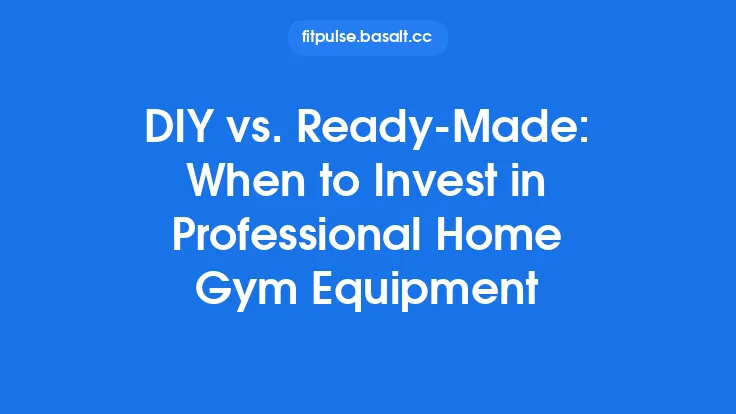When you bring a gym into your home, the excitement of having a personal training space can quickly be dampened—literally—by the clatter of dumbbells, the thump of a barbell hitting the floor, or the hum of a treadmill. While a lively workout soundtrack can add motivation, the unintended transmission of noise to adjoining rooms, neighbors, or even the next floor can become a source of frustration for both you and those around you. Fortunately, acoustic considerations can be woven into the design of your home gym from the outset, allowing you to enjoy powerful, effective sessions without disturbing the peace.
Below is a comprehensive guide that walks you through the science of sound, the most effective materials and construction techniques, and practical, budget‑friendly steps you can take to keep your home gym as quiet as it is functional.
Understanding the Sources of Noise in a Home Gym
Impact Noise vs. Airborne Noise
- Impact noise is generated when something strikes a surface—think of a kettlebell hitting the floor or a barbell being dropped. This type of noise travels through solid structures (floors, walls, ceilings).
- Airborne noise is produced by equipment that moves air, such as treadmills, ellipticals, or fans. It propagates through the air and can be heard in adjacent rooms.
Frequency Spectrum Matters
- Low‑frequency sounds (20–200 Hz) are especially problematic because they travel farther through building materials and are harder to block. Heavy weight‑lifting tends to generate these deep thuds.
- Mid‑range frequencies (200 Hz–2 kHz) dominate the whir of cardio machines and the clatter of plates.
- High frequencies (above 2 kHz) are usually less intrusive but can become noticeable in echo‑prone spaces.
Understanding which frequencies dominate your workouts helps you select the right mitigation strategies.
Selecting Flooring That Absorbs Impact
Floating Floor Systems
A floating floor consists of a resilient underlayment (often rubber or high‑density foam) that sits on top of the existing subfloor, isolated by a decoupling membrane. This design dramatically reduces impact transmission because the floor “floats” on the resilient layer, absorbing the kinetic energy of dropped weights.
- Materials: ½‑inch to 1‑inch rubber tiles, interlocking EVA foam, or specialized gym mats with a high Shore A hardness (40–60) for durability.
- Installation Tips: Lay a continuous sheet of acoustic underlayment (e.g., ¼‑inch dense rubber or mass‑loaded vinyl) before placing the surface tiles. Overlap seams and seal with acoustic tape to prevent vibration “bridges.”
Mass‑Loaded Vinyl (MLV) Underlayment
MLV is a dense, flexible material (typically 1 lb/ft²) that adds mass without sacrificing flexibility. When placed beneath a rubber gym floor, it boosts the Sound Transmission Class (STC) rating of the floor assembly, making it harder for low‑frequency thuds to travel through the structure.
Resilient Rubber vs. Foam
- Rubber offers superior durability and higher impact attenuation, especially for heavy‑weight zones.
- Foam is lighter and easier to install but may compress over time under repeated heavy impacts, reducing its effectiveness.
Wall Treatments for Airborne and Impact Noise
Decoupling Walls
A decoupled wall assembly separates the interior wall surface from the structural framing, preventing vibrations from passing directly through. Common methods include:
- Resilient Channels: Metal strips mounted perpendicular to studs, creating a small air gap. Drywall is then attached to the channels rather than directly to the studs. This simple retrofit can improve STC by 5–10 points.
- Double‑Stud Walls: Two parallel stud walls with an air cavity in between. While more space‑intensive, this method offers the highest isolation for low‑frequency impact noise.
Adding Mass
Increasing the mass of a wall improves its ability to block sound. Options include:
- Additional Layers of Drywall: Adding a second ½‑inch sheet of gypsum board (preferably with a sound‑damping compound like Green Glue sandwiched between layers).
- Mass‑Loaded Vinyl Sheeting: Applied directly to studs before drywall, MLV adds density without significantly increasing wall thickness.
Absorptive Surface Treatments
While mass and decoupling block transmission, absorptive panels reduce reverberation within the gym itself, preventing sound from building up and escaping through gaps.
- Acoustic Foam Panels: 2‑inch thick, high‑NRC (Noise Reduction Coefficient) panels placed strategically on walls opposite the main noise sources.
- Fabric‑Wrapped Fiberglass Panels: Offer better aesthetics and higher NRC values (0.7–0.9) while also providing fire resistance.
Sealing Gaps
Even the smallest openings—electrical boxes, door frames, and ventilation ducts—can act as acoustic shortcuts. Use acoustical caulk or expanding foam to seal:
- Gaps around baseboards (≥¼‑inch).
- Perimeter of doors (install door sweeps and acoustic gaskets).
- Openings for outlets (install putty pads or acoustic sealant).
Ceiling Solutions for Multi‑Story Homes
If your gym is located on an upper floor, the ceiling below is a primary conduit for impact noise. The following strategies help keep downstairs neighbors happy:
- Acoustic Ceiling Tiles: Install ½‑inch to ¾‑inch mineral fiber tiles with a high NRC (≥0.75). They can be mounted on a suspended grid that includes resilient hangers to decouple the ceiling from the joists.
- Resilient Clip Systems: Similar to resilient channels for walls, clips attach to joists, and a thin layer of drywall is then fastened to the clips, creating a floating ceiling.
- Additional Mass: Adding a layer of ¼‑inch MLV between joists and the ceiling board can further dampen low‑frequency vibrations.
Controlling Airborne Noise from Cardio Equipment
Enclosure or “Box” Design
For particularly loud machines (treadmills, rowing machines), consider building a partial enclosure using acoustic panels on three sides (front, sides, and top). This creates a semi‑sealed environment that traps sound while still allowing ventilation.
- Ventilation: Use low‑velocity, ducted fans equipped with acoustic silencers to maintain airflow without re‑introducing noise.
- Materials: Combine a rigid frame (2×4 lumber) with high‑density acoustic foam on interior surfaces and a decorative fabric on the exterior for a cleaner look.
Isolation Pads for Machines
Place heavy cardio equipment on purpose‑made isolation pads:
- Dense Rubber Pads: ¾‑inch thick, with a non‑slip surface.
- Sorbothane or Neoprene Pads: Offer superior vibration damping for machines that generate high‑frequency vibrations (e.g., elliptical cross‑trainers).
Maintenance for Noise Reduction
Regularly lubricate moving parts, tighten bolts, and replace worn belts. A well‑maintained machine produces less mechanical noise, reducing the need for extensive acoustic treatment.
Door and Window Strategies
Acoustic Doors
Standard interior doors often have hollow cores that transmit sound easily. Upgrade to:
- Solid‑Core Doors: At least 1¾‑inch thick, preferably with a dense wood or composite core.
- Acoustic Gaskets: Install perimeter seals that compress when the door closes, eliminating air gaps.
- Automatic Door Closers: Ensure the door fully latches each time, maintaining the seal.
Window Treatments
If your gym includes windows, they can be a weak point for both impact and airborne noise.
- Double‑Glazed Windows: Two panes of glass with an air gap dramatically improve STC.
- Acoustic Curtains: Heavy, dense fabrics (e.g., polyester‑cotton blends with a mass‑loaded backing) can absorb sound when drawn.
- Window Inserts: Clear acrylic or glass inserts that fit inside the existing frame add mass without sacrificing natural light.
HVAC and Mechanical Noise Management
Duct Lining
Acoustic insulation (fiberglass or mineral wool) inside supply and return ducts reduces the transmission of fan noise into the gym space.
Isolation Mounts for Units
If a portable air conditioner or dehumidifier is required, place it on vibration‑isolating mounts to prevent the unit’s motor vibrations from traveling through the floor.
Quiet Fans
Select fans with low‑speed, high‑efficiency motors and blade designs that minimize turbulence noise. Inline duct fans with acoustic housings are especially quiet.
Budget‑Friendly DIY Acoustic Enhancements
| Goal | Low‑Cost Solution | Approx. Cost (USD) |
|---|---|---|
| Reduce impact from dropped weights | Interlocking rubber gym tiles + ¼‑in. rubber underlayment | $2–$4 per sq ft |
| Seal wall gaps | Acoustical caulk (e.g., Green Glue Noiseproofing Sealant) | $0.50 per linear ft |
| Dampen cardio machine vibration | Sorbothane pads (4‑in. diameter) | $15 per pad |
| Add wall absorption | DIY fabric‑wrapped fiberglass panels (use recycled fabric) | $8–$12 per panel |
| Upgrade door | Install solid‑core door with perimeter gasket | $150–$250 |
Even modest investments—such as adding a layer of MLV under the gym floor or sealing gaps around doors—can yield noticeable reductions in transmitted noise.
When to Call a Professional Acoustic Consultant
While many acoustic improvements are DIY‑friendly, certain scenarios benefit from expert analysis:
- Multi‑Story Buildings with Shared Walls: Complex vibration paths may require detailed calculations to achieve desired STC levels.
- Low‑Frequency Dominant Noise: If heavy weight‑lifting is a core part of your routine, a professional can design a tuned isolation system (e.g., floating slab with spring mounts).
- Building Code Compliance: Some condo or apartment associations have strict noise ordinances; a consultant can provide documentation that your design meets or exceeds required standards.
A professional assessment typically involves on‑site measurements, modeling of sound transmission paths, and a customized mitigation plan.
Maintenance and Long‑Term Performance
Acoustic treatments are most effective when they remain in good condition:
- Inspect Flooring: Replace worn or compressed rubber tiles promptly; a compromised floor loses its impact‑absorbing properties.
- Check Sealants: Over time, caulk can shrink or crack. Reapply as needed to maintain airtight seals.
- Clean Acoustic Panels: Dust can reduce the absorptive efficiency of foam and fiberglass panels. Vacuum gently or use a low‑pressure air blower.
- Monitor Equipment Wear: As machines age, they may generate more noise. Schedule regular servicing to keep them quiet.
Summary of Key Takeaways
- Identify Noise Types: Distinguish between impact and airborne sources to target the right solutions.
- Add Mass and Decouple: Use mass‑loaded vinyl, extra drywall layers, resilient channels, and floating floor systems to block transmission.
- Absorb Within the Space: Install acoustic panels and high‑NRC materials to reduce reverberation and prevent sound from escaping.
- Seal Every Gap: Even tiny openings can undermine the best‑in‑class treatments; use acoustical caulk and gaskets liberally.
- Tailor Solutions to Equipment: Heavy weight zones need impact isolation; cardio zones benefit from vibration pads and enclosure strategies.
- Balance Budget and Performance: Start with high‑impact, low‑cost measures (floor underlayment, door seals) and layer additional treatments as needed.
- Plan for Maintenance: Regular upkeep ensures long‑term acoustic performance and protects your investment.
By integrating these acoustic considerations into the early stages of your home gym design, you create a workout environment that’s powerful, private, and neighbor‑friendly. The result is a space where you can push your limits without worrying about the noise echoing through the rest of your home—or beyond its walls. Happy training!





